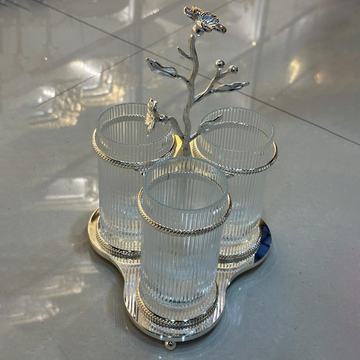The appearance of water spots on glassware could cause a lot of eyeache, especially if you're striving to keep your kitchen spotless kitchen or table for your guests. The spots are usually caused by the minerals that are found in hard water, which leave streaks of cloudy staining that take away from the shine of the glasses you love. However, getting rid of them could be simple if you use proper methods and preventive steps. In this thorough guide, we'll discuss the causes behind water spots, the most effective ways to remove them, and ways to prevent new spots from showing up. In the end, you'll have everything you need to maintain the shine of your glassware.
1. Understanding Water Spots on Glassware
Water spots, often called limestone scale or mineral deposits, are formed when water containing minerals like calcium and magnesium melts off the glass's surface. As time passes, the mineral deposits bond to the glass's surface, resulting in cloudy or whitish streaks. While they aren't a sign that your food is dirty, they could give an impression of poor sanitation or poor care.
For many US families, the main problem is that of hard water that has higher levels of minerals than soft water. Suppose untreated mineral buildup may become harder to break down, which requires the use of more strenuous cleaning techniques. Furthermore, repeated deposits of minerals may cause "etching," where the glass becomes permanently etched or looks damaged. However, by following the correct method, it is possible to eliminate water spots and restore the shine of your glassware.
2. Essential Tools and Materials (Bullet Points)
- White Distilled Vinegar: An acid is mild enough to dissolve minerals effectively.
- Baking Soda: It provides a soft abrasive to take off stubborn residues without scratching.
- Lemon Juice: It contains citric acid, which can help break down hard water minerals. It also leaves a fresh smell.
- Microfiber Cloths or Lint-Free Towels: It is ideal for polishing and drying without leaving streaks or lint.
- Soft Sponge or Non-Abrasive Scrubbing Pad: It protects delicate glassware while taking off hard-to-remove scratches.
3. Common Causes of Water Spots
While hard water may be the primary cause, others can also cause or cause water spots. For instance, excessive dish soap could leave marks on your glassware. This makes it more likely for minerals to remain. The second reason is that relying on drying your dishes with air allows drops of water to slowly evaporate and leave the behind of a greater amount of mineral. Additionally, a dirty dishwasher - where the spray arms or filters are clogged with mineral deposits, can result in stained glasses.
Be aware of potential dangers and avoiding them, you can modify your routine of cleaning to reduce the chance of. Making small changes, like making the switch to a stronger rinse aid, washing the dishwasher on a regular basis as well as wiping glasses clean promptly can go a long way towards avoiding those ugly marks.
4. Step-by-Step Removal Techniques
If you're looking to remove water spots, a variety of strategies are available to tackle those toughest spots. It doesn't matter if you favor natural techniques or prefer the durability of commercially-produced methods, there's one to meet your requirements.
1. Vinegar Soak
An eco-friendly and popular solution is to make vinegar soak. Start by mixing equal portions of white distilled vinegar with warmer water inside a huge container or in your kitchen sink. Place the glasses into the solution for around 30 minutes. If the stain is particularly hard to remove, allow the solution soak for up to 1 hour. After that, wipe the glass using an absorbent sponge or a cloth and rinse with water that is clean. Clean each item quickly to stop any new spots from forming.
2. Baking Soda Paste
If the vinegar on its own isn't doing enough to solve the problem, baking soda could give you extra power for scrubbing. Make a paste by mixing some vinegar together with baking soda (cautiously since it can spark). The paste should be applied to water spots, and allow it to remain for 5–10 minutes, then gently rub it in a circular direction. Baking soda's gentle abrasive nature assists in lifting stubborn remnants of residue without damaging glass surfaces. Dry and rinse completely with a clean, lint-free cloth.
3. Lemon Juice Rub
Another healthy, pleasant-smelling option is to use lemon juice. Take a slice of a freshly squeezed lemon and apply the juice directly on the spots. Let the citric acid in the juice to take effect for several minutes before melting minerals. Rinse using warm water, and then dry the glassware to avoid any droplet scratches. Lemon juice is soft enough to be used on most glassware, However, you should be aware of older or delicate items.
4. Commercial Cleaners
In the case of stains that are extremely difficult to remove or glassware that has been neglected for a long time, commercial water stain removers are required. They are designed to dissolve mineral deposits in a short amount of time. Just follow the directions on the package, which generally involve putting the cleaner on and letting it rest for the recommended amount of time before scrubbing it and then rinsing. Although these cleaning products may be efficient, they usually contain stronger chemical compounds than natural ones. If you do decide to utilize them, make sure you wear gloves according to the directions and clean your glassware in order to get rid of the residue.
5. Preventing Future Water Spots
Prevention is less difficult than frequent spot-removal. With a couple of simple techniques in your everyday routine, it is possible to keep the glassware in top condition for the longer term.
One of the most efficient methods is to use a rinse aid when making use of the dishwasher. Rinse aids allow water to move off glassware, thus reducing the amount of droplets that can result in mineral deposits. If you choose to wash dishes yourself, you should make sure to dry them immediately with the help of a microfiber cloth rather than letting them air dry. It reduces the amount of time that water needs to evaporate and sit and take mineral deposits with it.
If you live in a household with hard water, the installation of water softeners can be an investment over the long term that dramatically minimizes the buildup of minerals. The water softener eliminates or neutralizes the calcium and magnesium content of hard water. It benefits not only the glassware you use, as well as your plumbing and appliances. Also, make sure you regularly cleanse your dishwasher. Remove any sludge from the filter, then run the dishwasher through with vinegar, then apply an appliance cleaner or descale periodically to wash out any mineral residue.
6. Caring for Specialty and Delicate Glassware
If you have costly glassware, antique crystal or other items that may be fragile, you should take extra precautions. Some of these items could have distinctive design or compositions, and are more prone to being scratched and etched. Use lukewarm water in place of cold or hot water, since sudden temperature variations may crack glass that is fragile.
If you are dealing with unusual items or pieces that are sentimental, You may wish to steer clear of chemical cleaning products from commercial stores entirely. Instead, you should stick to more gentle methods, such as a light vinegar soak or gently rubbing lemon juice on the pieces. Carefully dry the pieces using the help of a gentle, clean cloth in order to maintain brilliance and clarity. When you treat these pieces with respect and care, you will be able to extend their lives and relish the beauty of these pieces for a long time.







